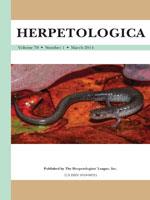We describe a new species of Pseudopaludicola endemic to the Caatinga ecoregion of northeastern Brazil. The new species is characterized morphologically by small size, lack of T-shape terminal phalanges, smooth upper eyelids, presence of abdominal and vocal sac folds, light cream-colored vocal sac, and short hind limbs with tibia–tarsal articulation reaching the eye. The tadpole has a globular body shape, low tail fins, and a ventral oral disc bordered by a single row of marginal papillae with a wide anterior gap and two ventrolateral gaps; oral formula: 2(2)/2(1). The advertisement call consists of a well-defined sequence of notes comprising three nonconcatenated pulses, each with long interpulse intervals (111 ± 21 ms) and average note duration of 238 ± 31 ms. The mean dominant frequency is 5636 ± 300 Hz, and increases from the first to the last pulse in each note. The advertisement call easily distinguishes the new species from all other congeners for which calls are known.
How to translate text using browser tools
1 March 2014
A New Species of Pseudopaludicola (Anura: Leptodactylidae: Leiuperinae) from Northeastern Brazil
Felipe de Medeiros Magalhães,
Daniel Loebmann,
Marcelo Nogueira de C. Kokubum,
Célio Fernando Baptista Haddad,
Adrian Antonio Garda
ACCESS THE FULL ARTICLE

Herpetologica
Vol. 70 • No. 1
March 2014
Vol. 70 • No. 1
March 2014
Advertisement call
Caatinga
distribution
larval morphology
Pseudopaludicola pocoto





